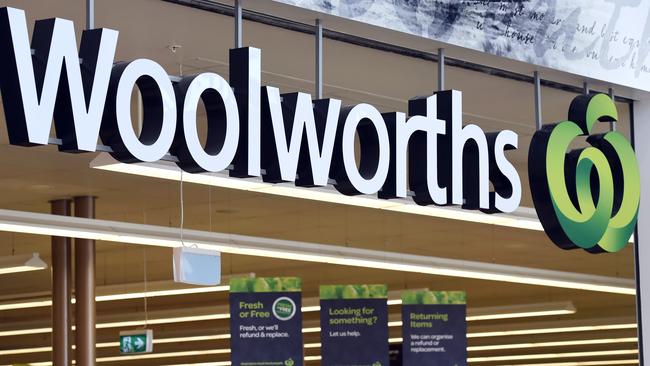Woolworths slumps to $1.23bn loss, with earnings sliding 40pc
Woolworths has slumped to a $1.23bn loss as its once mighty supermarkets arm suffered a 40pc slide in earnings.

Woolworths has slumped to a loss of $1.23 billion, its first loss in 23 years as a public company, as more than $3 billion in impairments flowing from its disastrous expansion into hardware and mounting losses at its Big W chain overwhelmed early signs of progress in the transformation of its flagship supermarkets business.
In what Woolworths (WOW) chief executive Brad Banducci has described as a year of “unprecedented change’’ for the retailer, its once mighty supermarkets arm — the biggest supermarket chain in the country — saw earnings slide by more than 40 per cent.
And shareholders will feel that pain, with Woolworths’ final dividend to investors crunched by more than 50 per cent. It is the lowest dividend payout in 10 years.
At 10.15am, Woolworth shares were up 7pc to a 10-month high of $25.91.
Woolworths earlier said it had lurched to a loss of $1.23 billion for fiscal 2016, a swing from the profit of $2.146 billion recorded in 2015.
Revenue for fiscal 2016 was 1.2 per cent weaker at $58.08 billion.
Reflecting the pain from its accounts, which included more billions of dollars in impairments and writedowns, Woolworths has sliced its final dividend by more than half, with the final dividend of 33 cents per share, down 54.2 per cent on the prior year. The final dividend is payable on October 7.
The company said net profit from continuing operations was $803.5 million. Profit before significant items, which include $3.2 billion in provisions and non-cash impairments to its hardware and struggling retail businesses, was $2.56 billion, down from $3.97 billion in 2015.
Mr Banducci was appointed CEO in February with a mandate to turn around Woolies’ underperforming supermarkets arm, return Big W to profitability and clean up the mess at its hardware chain Masters.
“We are seeing early signs of progress as we work to restore our competitiveness and improve our culture in Australian food,” he said. “We have also addressed significant issues facing the group with the decision to exit home improvement and decisive action taken on Big W to reposition the business.
“While we are seeing early signs of momentum, we are not underestimating the size of the task that lies ahead, especially given the highly competitive nature of the markets in which we operate. As we have consistently said, this is a three to five year journey.”
Yesterday that transformation picked up speed when Woolworths announced the closure of its loss-making Masters chain, with the assets to be stripped and sold off to various investors for $1.5 billion.
Woolworths said today its food and petrol business, which only a decade ago was churning out super profits, posted a 40.8 per cent dive in pre-tax earnings to $1.759 billion. For the first time Woolworths has broken out the performance of its liquor arm, which includes outlets like Dan Murphy’s, with earnings for that division up 3 per cent to $483.8 million.
As expected, Big W slumped to a loss of $14.9 million, against a profit of $111.7 million in 2015, while its hotels arm saw earnings slide 11.1 per cent to $208.5 million.
Woolworths’ New Zealand supermarkets business recorded a 6.2 per cent drop in earnings to $284.4 million.
Australian food sales for the year were $34.8 billion, a decrease of 0.2 per cent on the previous year. Comparable sales declined by 1.3 per cent in fiscal 2016 primarily driven by significant price investment, as Woolworths pushed down prices to maintain its competitive edge.
Comparable sales in the fourth quarter showed the smallest decline for the year, down 1.1 per cent. Yesterday Coles reported like-for-like sales growth in the fourth quarter of 2016 of 2.8 per cent, with Coles now beating Woolworths in terms of quarterly sales growth for 28 quarters in a row.
“Top of my five priorities is getting our customers to put us first and making the right business decisions to enable this to happen,’’ Mr Banducci said.
“We are regaining competitiveness with improving customer metrics and sales and transaction growth demonstrating our customers are recognising our investment in lower prices, better service, fresh fruit and veg and improved store experience. Our improving team engagement scores show we are also changing our culture for the better.”







To join the conversation, please log in. Don't have an account? Register
Join the conversation, you are commenting as Logout